We were shocked by all the colourful birds flying around us while in Malindi, not something we were expecting. Fortunately, there were a number of guides on the walls stating what they were and plenty of interesting facts about them, but I struggled to find anything online, so I’ve tried to include everything I could find. You won’t quite see the depth of birds you would expect to find on a tour of the Maasai Mara, but it’s still substantially more than back home.
African Golden Weaver Ploceus Subaureus
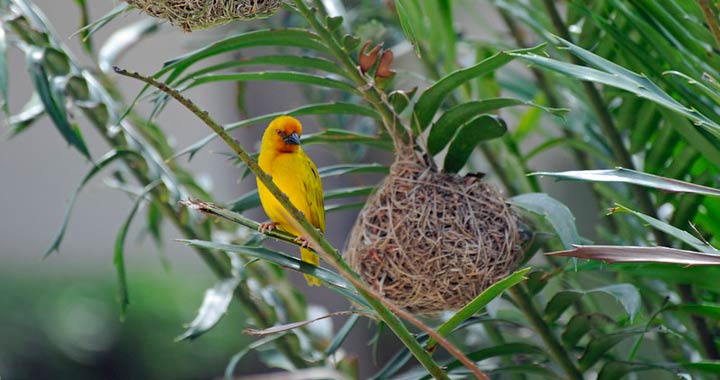
Identification: 11.5-14cm (4.5-5.5″). The male is a bright yellow bird with a heavy and strong dark bill. The wings and back are slightly greener in colour. The head and face is a dark orange fading to yellow on the breast, while the eyes are red.
The female adult is a duller yellow with a greenish black head, a white or very pale yellow belly, slightly pinkish ill and red eyes.
When they are young, they are like the female, but with more white on the belly. The young are very difficult to distinguish from those of the golden palm weaver.
Status: They are fairly common in coastal lowlands, found more patchily inland to the Athi river and up to Nyeri.
They are highly gregarious and like to move together in large, noisy groups, nesting in trees and shrubs, usually near water. The nest is spherical with a bottom entrance normally built from grass or shreds of palm leaves.
We had the benefit of seeing a huge number of these at the Turtle Bay Beach Resort.
Golden Palm Weaver Ploceus Bojeri
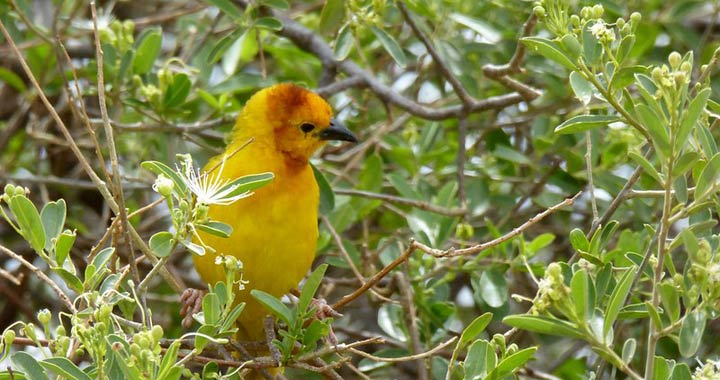
Identification: 14cm (5.5″), the male is a beautiful yellow, slightly greener on the back and with a bright golden orange head. They are brighter and more orange than the African golden weaver. It has a dark, bib-like orange-brown patch on its upper breast. The bill is short and stout and very dark black (appearing blacker than the African golden weaver). It also has dark eyes (the adult African golden weaver has red eyes).
The female is a duller yellow, with a green, lightly streaked back. The best feature to look for is the two-tone bill, the upper half of the bill is darker and the lower half is pale yellow.
The young ones are like the female but slightly duller in colour and brown eyes, but still have the two-tone bill.
Status: They are fairly common residents all along the coast and inland up the Tana river to Meru, Samburu and South to the Athi river.
The weavers are not present in Europe at all, but are closely related to sparrows, sharing the same heavy bill used for eating seeds.
A gregarious and noisy species that is quite often found breeding alongside the African golden weaver which builds a very similar type of nest. The nest is built by the male and is most commonly suspended under palm leaves. It is spherical and, unlike many other weaver nests, lacks an entrance tube.
Hadada Ibis Bostrychia Hagedash
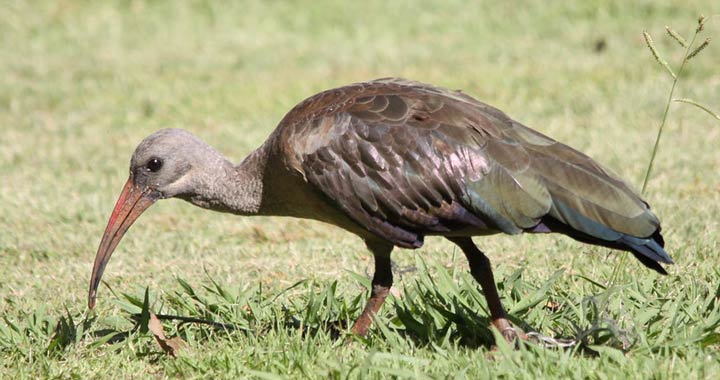
Identification: 76-89cm (30-35″), a large, relatively short-legged bird with a long curved bill about two times the length of its head. The body is generally dark black-brown with large iridescent green patches on the wings. It has a white stripe below the cheek and the mainly black bill has a red ridge along the top. It has a very noisy, raucous call that can be heard a long way off. It’s often found feeding in pairs on the ground.
Status: They are widespread and locally common in areas of higher rainfall and particularly in the highlands.
The glossy Ibis Plegadis Falcinellus is a rare breeding bird mainly found in Southern Europe and also found in the Kenyan wetlands. The Hadada Ibis is a chunkier, heavier bird with a shorter and stouter neck, legs and bill and has green wing patches rather than the overall purple effect of the Glossy Ibis.
The Hadada Ibis feeds mainly on the ground where it probes in soft soil for insects and worms. It’s normally found feeding in groups of two to five birds, but roosts together at night in trees in groups of sometimes over 50 birds.
They are highly vocal, tending to call loudly on the way to or from their feeding grounds at dusk or dawn. They breed as single pairs with the nest normally being built in the fork of a tree up to 30m above the ground.
Pied Crow Corvus Albus
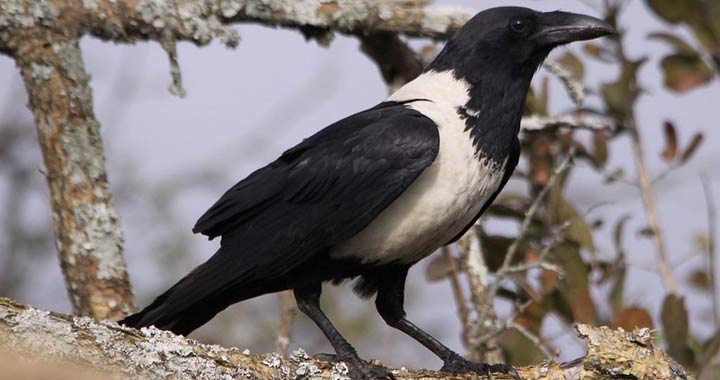
Identification: 46cm (18″), this is an unmistakable, large black bird with a white ‘vest’. It has a white belly and breast extending around the back of the neck as a broad collar. The bill is heavy and strong, the legs are medium-long length and are also very strong.
Status: These are common and widespread, found in open country and present in all major towns.
The raven and carrion crow are closely related but lack the white, being entirely black or brown-black.
They occur mostly in small groups though large flocks can form when attracted to a food source. The large numbers often roost together as well. They are regularly found around rubbish dumps scavenging, a habit which it is well known for.
African Pied Wagtail Motacillia Aguimp
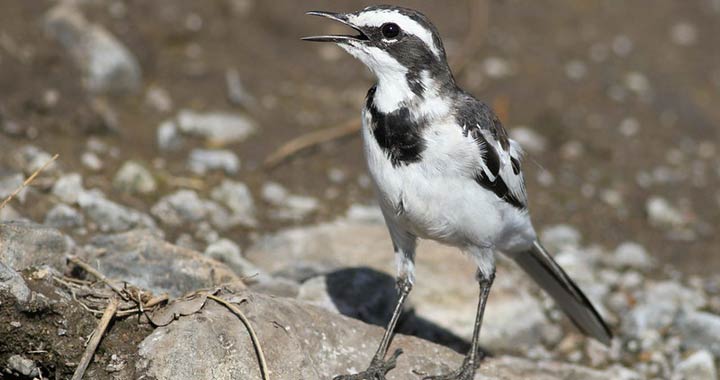
Identification: 20cm (8″), a small, slender black and white bird with a fine bill and a long tail that is constantly wagging up and down (hence the name), mainly black above with a large white patch on the wings and a white eye-brow. It has a broad black band across its breast, relatively long-legged for a small bird. The call is a clear, sharp ‘tuwhee’, the songs are clear, varied piping of whistled notes in repeated phrases.
Status: Common and widespread bird in moister habitats, often found in close proximity to human habitation on lawns and around buildings.
The white wagtail motacilla alba (or pied wagtail in Britain) appears very similar in many ways being also black and white, but it’s smaller with much more white on its face and is greyer on the back.
They are resident (non-migratory), usually solitary or in pairs, while they feed on insects which it picks from the ground or flicks up into the air to catch. At night they congregate in large roosts of up to several hundred birds.
African Palm Swift Cypsiurus Parvus
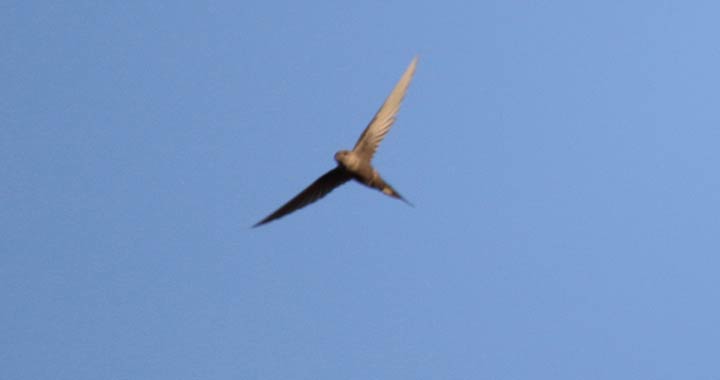
Identification: 14-15.5cm (5.5-6″) a very small slim swift (aerial birds with long curved wings, very short legs and a short, broad bill), with long thin wings. It has a pointed tail, plumage in a uniform brown colour, always seen in flight, flying fast with rapid, shallow wing beats. The call is a high, but slightly rough trill or ‘scream’.
Status: Widespread resident mainly below 1,800 metres altitude, being particularly common along the coast.
The Eurasian swift Apus apus and Pallid swift apus pallid are both similar in shape, but are considerably larger with broader wings and shorter, less forked or pointed tail. The Eurasian swift is also much blacker and has a pale throat.
This species has a remarkable breeding strategy. It makes its tiny nest out of bits of grass or feathers it collects whilst in flight and glues it with saliva to the single frond of a palm leaf. It then also glues its single egg to the nest so that it cannot fall off when the leaf is blown by the wind. When the young hatches, they must cling on to the leaf with their strong claws, if they are not to fall off and die. Palm Swifts catch all their food (insects) in flight and cab forage several 100m above the ground, though are more commonly found foraging low.
Common Bulbul Pycnonotus Barbatus
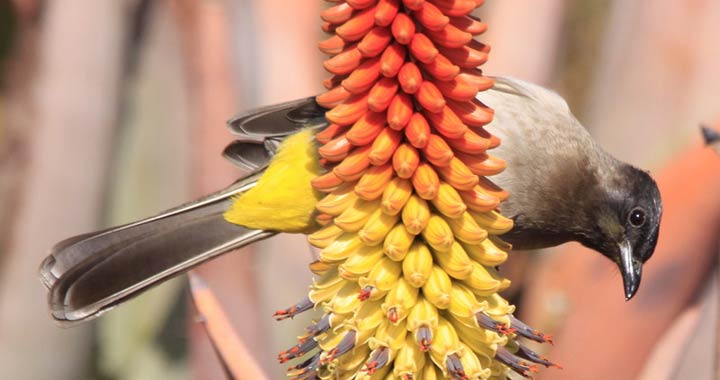
Identification: 15-19cm (6-7.5″) a very well known medium to small bird, easily recognised by the dark brown-black tail, grey white underside and bright yellow under the tail which converts or vents. In Malindi, the local race at the coast has a white ‘ear’ patch and a scaly effect on its breast.
Status: Found throughout Kenya in all habitats except wetlands and dense forest. Often very common and has adapted easily to habitats altered by humans, especially suburban gardens.
This family is not found in Europe, the nearest relatives being the thrushes, but which differ in being generally more ground-dwelling, spending less time feeding in trees and bushes, and in having longer legs.
They are usually found in pairs, but groups (especially family groups) sometimes occur and may call together just after dawn. Larger numbers will gather together when attracted to a good food source such as a fruiting tree. It is often bold and fearless of humans and has become a nuisance in some hotels where it feeds off the tables and has diversified its diet with sugar and butter.
Not sure where else to head on your holiday? Have a read through my Kenya 2 week itinerary.